THE LATEST IN TECHNOLOGY AND RESEARCH TO KEEP MINERS SAFE BOTH BEFORE AND AFTER AN EMERGENCY
By Donna Schmidt, Field Editor
The idea of mine rescue is a bit of a paradox: it represents a significant facet of the mining industry, from mine rescue teams and competitions to safe working initiatives, and it is a subject of great focus for research and product development. However, at the same time, it is a topic some put on the back burner mentally, in part because of negative connotations including injury, the potential for death and the unthinkable emergency that could put the lives of workers in peril.
That said, underground mining serves itself best by staying proactive and, when a lapse in safety occurs, gleaning as much as possible from the incident and what went wrong. There are many systems and products available today because of a lesson learned from a terrible day on the job — case in point, refuge shelters — but just as many developed by those willing to think outside the box.
As miners make an effort to work safer, there are many out there willing to work in collaboration with operations to keep them that way, from atmospheric monitoring solutions to the best in breathing assistance. There is also a significant evolution occurring in training and the virtual reality space.
Staying ahead of the curve comes down to one key idea: communication. Mining is doing a great job of coming together, from operations to suppliers to researchers and others, bringing about ideas for a safer tomorrow. As that continues, look ahead for more on mine safety’s latest and where it is heading, according to some of the sector’s top companies.
| Dräger played a significant role in the very first mine rescue competition in 1911. |
A LONG-STANDING PARTNERSHIP
One doesn’t make it to 125 years in business without doing at least one thing right, and Dräger is a great example of that. A part of the U.S business landscape since the early 1900s, and launcher of the first closed-circuit breathing apparatus (CCBA) in 1907, the company has learned more than a few things about mine safety along the way.
Dräger was also quick to make its place in the mining community, playing a significant role in the very first mine rescue competition in 1911; moreover, many mine history buffs and hardcore mine safety devotees will know the origin of the term “Drägerman” used for mine rescuers of the early times (a term still used today) and even Dräger’s mention in a famous 1938 Superman comic book.
According to Kent Armstrong, global business development manager for Dräger’s mining segment, the company has built upon that over the decades to shape where it is today and where it will go in the future; in fact, it is love for the industry that has helped Dräger find inspiration for product improvements and enhancements.
“We are mining technology junkies and we’re always looking at the techniques being used to go ‘farther, deeper and faster’ in mines,” he said.
“Recognizing new hazards, like NO2 emissions, inspire us to innovate and create new products to keep miners safe. Mine rescue requirements are in tune with the marketplace — constantly changing, and we’re challenged to make equipment that can be worn safely for hours during an emergency.”
Today the company is known for its daily-use respiratory protection line as well as its emergency breathing solutions, professional mine rescue lineup and its gas detection products. It would be a fruitless task to find a mine rescuer today who has never encountered a Dräger in his or her experience.
As Armstrong noted, their commitment to those who put the safety of others above themselves is unwavering.
“[We] support our products in the field and the training of those who use them,” he said. “Additionally, we believe that support of competitions reinforces proper technique and the right level of knowledge for miners and mine rescuers to always be prepared.”
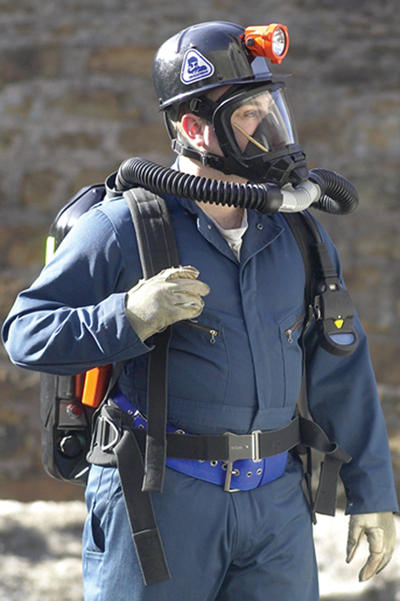 |
| A modern rescuer dons a Dräger SCBA. |
From Dräger’s perspective, the biggest benefits to today’s mine rescue crews is an unprecedented level of care and more rapid response than ever.
“This better response comes from a continuous cycle of learning and practice that allows for constant emergency preparedness,” he said. “Dräger is always looking at ways to enhance technology to better equip today’s mine rescue teams.”
New requirements and consistently changing safety regulations have resulted in an ever-changing plan of attack, as it were, for operations in terms of safety. While companies are always working goals around safety, the environment, and training, the challenge for Dräger and others in the space is anticipating the changes ahead of time, then exceeding what is needed.
Looking at the whole picture, the industry is doing well in terms of mine rescue, Armstrong said.
“The formation of mine rescue organizations are a tremendous step in the support of both miners and the industry as a whole,” he said. “Due to a higher level of vigilance after disasters, there has been greater attention paid to safety with better equipment, more available equipment, and more frequent training. There’s no question operators are on the right path.”
“There’s [also] been an increase in rescue competition and MERDs (mine emergency response development) exercises continue to allow miners to increase their skills. As long as there continues to be attention paid to knowledge and training, things will continue to get safer.”
Dräger, which has spent all of 2014 celebrating its 125th anniversary, has its widest-ever product solutions portfolio; its mining segments include gas detection and personal protective equipment such as filters and SCBAs; emergency response and planning; escape requirements including rescue and shelter systems; and workforce drug testing. The company also offers training on its products and services, both online and in person.
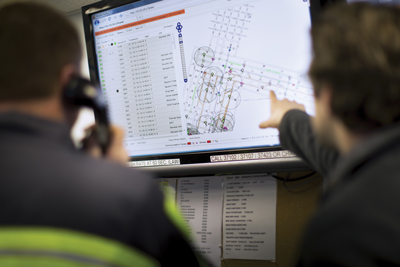 |
| Looking at mine movements and incoming monitoring data in real time with the CommTrac user interface. |
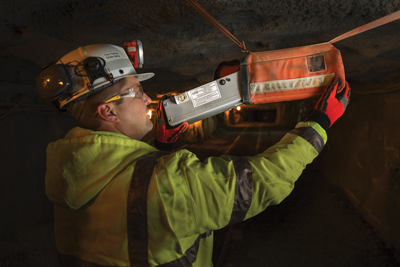 |
| Strata installing the CommTrac system at a mine. |
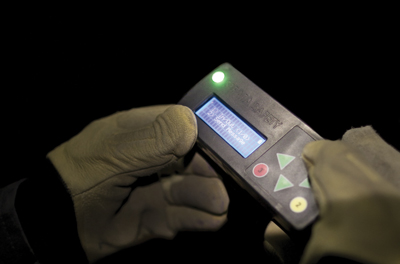 |
| In addition to its wireless communications, Strata’s focuses also include refuge alternatives, gas monitoring and AMS. |
TRACKING SAFETY FROM EVERY SIDE
Strata’s well-known battery powered and completely wireless communications and tracking system, CommTrac, meets federal requirements for post-accident two-way communications and tracking. Its physical compactness and ease of installation, lends itself perfectly to mine rescue operations.
“The system remains operational post-accident and contact with the surface can be very quickly and easily re-established if there is a break in connection at the time of the event,” the company said. “Rescue teams can carry in replacement nodes and set them up as they advance into the mine.
“Connectivity and communication will automatically be re-established once the nodes are within range of operable nodes underground. Personnel in the central control room will immediately be able to communicate with and track miners trapped underground, as well as watch the progression of the rescue teams.”
Leveraging the power and flexibility of CommTrac along with the versatility of U.K.-based Trolex Sentro 1 gas detectors, is one of Strata’s newest collaborative efforts in the area of atmospheric monitoring.
Intrinsically safe, battery-powered and completely wireless Strata/Trolex Sentro 1 detectors can be quickly deployed underground at a standard spacing of 1,000 ft along a belt drive, and lesser distances as may be required by individual mines or dictated by ventilation quality.
In day-to-day use, detectors measure gas concentrations every second and report data every 90 seconds and the resulting data is then transmitted over CommTrac to a central surface control room. In emergency situations, the monitors remain operational and go into alert status. Gas levels are measured and transmitted to the surface every second, providing mine operators with full knowledge of the underground environment.
A specially designed graphic user interface at the surface displays gas readings, alarms, operational status and the battery voltage of each detector underground. An illustrated mine map indicates the exact location of each unit and its real-time operating status. This optimizes and simplifies mine atmospheric monitoring as well as gas detector maintenance. Two-way communication with the gas detectors underground enables remote control of the units and mine operators can turn units on and off, adjust data acquisition rates, monitor and adjust sensor thresholds, and activate or deactivate emergency alerts/alarms. Furthermore, with two digital inputs and two digital outputs included, remote control of other underground devices such as pull-cord switches, remote pumps and contacts on fire suppression systems is possible. All controls are initiated at the user interface on the surface.
The newest addition to Strata’s wireless atmospheric monitoring line is the Mine Safety and Health Administration (MSHA)-approved refuge chamber Sentry integrated with Strata’s communication technology.
Sentry units detect and monitor carbon dioxide, carbon monoxide, oxygen and methane gases, as well as humidity levels and atmospheric pressures inside the refuge chamber. A sampling pump facilitates the testing of air directly outside the chamber.
When the refuge chamber is utilized in a mine emergency, the activation of the Sentry unit will send an alert to the surface control room, informing personnel that the chamber is in use.
All data readings taken by the system are then streamed over the wireless communications networks to the surface control rooms for full acknowledgment of the environmental conditions in and around the chamber.
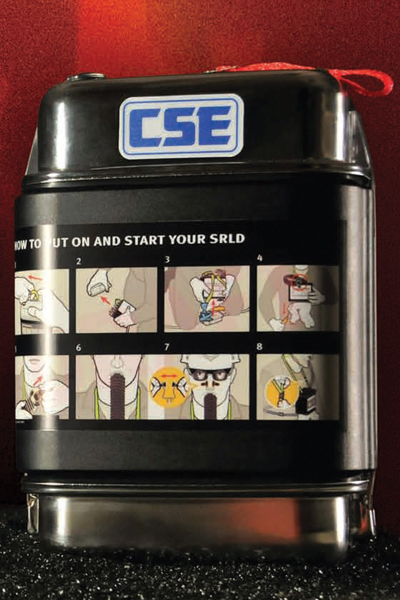 |
| CSE’s SLRD unit is the smallest 60-minute belt-wearable SCSR available on today’s market. |
BREATHING EASIER
A producer of gas monitors since 1974 and self-contained self-rescuers (SCSRs) in the U.S. since 1982, Pennsylvania-based CSE has been a central name in the mine rescue and mine safety circle for decades.
Today, the company’s most popular draws in SCSRs and monitors, respectively, are the CSE SRLD and the CSE G4, both commercially available globally.
The SLRD, or self-rescuer long duration, has a rated duration of 60 minutes and provides faster oxygen generation at the start of deployment. In addition to offering enhanced safety, reliability and performance over past unit designs, the SLRD is the smallest (8.5 x 6 x 4.25 in.) 60-minute belt-wearable SCSR available on today’s market. It also weighs under 6 lb, lightening the load for the workers donning them.
The G4 portable, multigas gas detector measures levels of one to four gasses, including oxygen, combustibles such as CH4, and two toxics including H2S, NO2, NO and CO. Each unit, which carries a two-year warranty through CSE, has a 25-hour battery run time and an operational interface that is easy to read and follow. A backlit screen also aids in accurate readings underground.
Both of these products, much like others in its line, are developed and improved thanks to feedback from the industry.
“We develop and manufacture products that keep miners safe and save lives,” according to Steve Swanson, CSE president and COO. “We are part of a close-knit community of hard working men and women and respond to their needs, including compliance with regulatory requirements.”
A vital segment of CSE’s work with the mining community is its training efforts, particularly with SCSRs. As many workers naturally may not give much thought to an SCSR’s operation until the time when it is needed, the company offers and provides hands-on training to all operations and miners, using a training method directed to those miners who carry the unit on their belt. According to Scott Shearer Jr., CSE respiratory product specialist, this proper training helps keep them knowledgeable about how to use as well as care for their SCSR so it will always be ready.
“We also offer our specialized class ‘Train the Trainer.’ This course is for any safety personnel or trainers who then go and train other miners,” Shearer said. “The class covers information about the SCSR in great detail, tips on how best to run a SCSR training class, and also utilizes a lot of hands-on training…such as donning the SCSR, and getting to experience a live-trainer. Many participants have stated they felt the class will allow them to become better trainers.”
CSE also offers thorough training to mines on the operation and maintenance of its gas detection systems; once complete, the user can immediately use his or her knowledge of the system’s inner workings to provide a safer working environment and ensure critical equipment is working properly.
On the topic of mine rescue, CSE’s Swanson echoed the sentiment that mine rescue teams, and the dedicated members that volunteer their time to be a part of them, are critical to the safety of all miners. In addition to being trained for emergencies, crews often increase the general awareness and preparedness of those around them.
“Operators are certainly headed in the right direction,” Swanson said of efforts in training, competition activities and other related mine rescue activities. CSE is working hard to stay ahead of teams’ needs from the supplier side.
“Manufacturers respond to the needs of the market [and] some are better than others,” Swanson said. “CSE is proud to be an industry leader in R&D. As a case in point, we believe that we may be the only manufacturer with a new 60-minute SCSR (soon to be submitted for testing), which meets MSHA/NIOSH regulations taking effect next April.
“We also work hard with the belief that when faced with an emergency, the right training, and the right SCSR, can help the miner get to safety and not have to wait for a rescue. Thus helps keep both the miners and mine rescuers safe.”
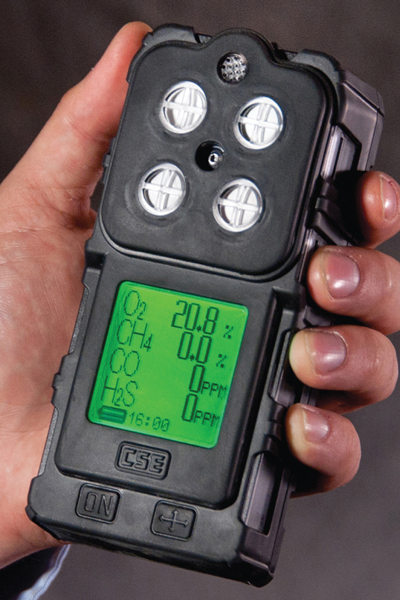 |
| The CSE G4 portable multigas gas detector measures levels of one to four gasses. |
THE ROLE OF TECHNOLOGY
Without a doubt, the best way for mine rescuers to polish their craft is through training. For many, that means classroom education, physically and mentally demanding practice sessions and competitions throughout the year. However, historically, other venues like a football field-like outdoor space or rehabilitated warehouse facility have had to suffice to give rescuers their needed experience; the lucky ones will have access to a handful of rehabbed mine sites for training.
Today’s mine rescue training is perhaps the most rapidly advancing scene in all of coal mining. A generation of men and women — one of the first to have exposure to advanced digital technology nearly all of their lives — are entering mining en masse with technological talent banked in their minds that is looking for an outlet.
That has created a perfect tie with the ever-evolving area of virtual reality (VR). Generally, an industry that has bucked technological change in the past is now embracing it full-force — and the younger mining set is leading that charge. Look no further for the success of VR than in today’s specialized training programs and extensive research in the area of emergency preparedness and escape.
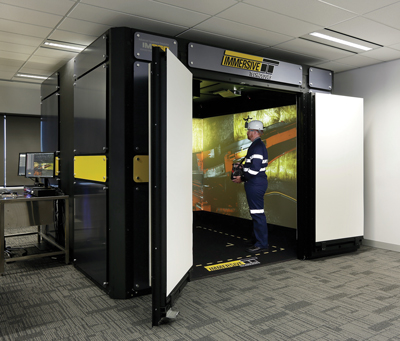 |
| A miner training inside an Immersive Technologies VR unit. |
IMMERSIVE TECHNOLOGIES TAKES ON TECH
Immersive technologies has one of the most extensive VR-based product lines, from surface to underground and even process plant solutions. Users can become familiar with a specific location before ever setting foot on the property, or hone evacuation and emergency skills long before they are ever needed.
IT’s world-first RealMove system allows operators to freely walk around a site and equipment for realistic familiarization, and its RealView technology allows trainees to see their view updated based on their head and body position and permits a user to peer around visual obstructions, providing the ultimate in training immersion and realism.
Specifically, RealMove technology allows operators to freely walk around the mine and equipment, allowing for realistic training for “red zone” avoidance, proximity sensor training, prestart and walk around.
When coupled with Immersive Tech-nologies’ removable motion platform, the IM360 offers high frequency motion cues for seated machines, aligning operator movement with display upon the uninterrupted high-definition 360° display.
“Original equipment manufacturers, MSHA guidelines, and industry best practice are tightly integrated within the Advanced Equipment Simulators,” Senior Product Manager Greg Karadjian said. “This attention to detail, flexibility, and fidelity gives trainees more in-depth machine knowledge and delivers rapid, correct and effective learning and assessment for your operation’s needs.”
The company has been marketing its solutions as independent products since 2013, and its highlight customizable training program options include general evacuations, escapes where the primary escape way is blocked or where both primary and secondary paths are obstructed, scenarios for workers seeking refuse chambers.
“When we looked at the underground coal mining sector, we realized that there was very little done to address industry problems and provide solutions for training and assessment for mine evacuations, emergencies [and] site familiarization,” Karadjian said. “Our focus was to help solve these types of challenges and deliver real results, not just introducing new technology that would go unused or unsupported. With a growing number of simulation-based training products available on the market, savvy miners are increasingly assessing the credentials of these tools for real value.”
As a result, Immersive Technologies’ advanced equipment simulators are the only fully supported solution of their kind in the mining industry. The company also stressed that its service agreements include scheduled system upgrades, so the latest in technology and methodology is always available for a realistic learning experience.
“The development of these upgrades is driven by evolving mining industry needs, using input provided by customers and equipment manufacturers. This ensures that our customers are able to continually achieve quantifiable improvement in their mining operations.”
Some of the company’s underground equipment solutions include continuous miners, longwalls, roof bolters and shuttle cars. Of course, the more users know about each, the more safely they can work overall, hopefully negating an equipment-related emergency situation.
As IT’s Karadjian noted, the focus has shifted in the current coal climate to “production, production, production” but the skills being polished in VR training are still in the front of the mind.
“Our cutting behavior is so realistic that, for example, the miner will crawl up the toe before digging in,” he said, adding that those signals are key to operators fine-tuning their cut sequences for optimal production.
“There is a lot of emphasis on rescue teams, and that is essential for responding to an emergency that has already occurred,” Karadjian said. “The largest benefits we see from our RealMove technology is that for the first time, they can practice evacuation training and emergency response, and be assessed objectively and independently. It is an industry first.”
Additionally, Immersive said that, with regard to its IM360 platform specifically, it significantly shifts the entry price for evacuation-based VR training downward.
That’s not to say there haven’t been obstacles in getting virtual reality technology, cost being just one.
“There have been two major hurdles to getting this technology in the field, and neither are market interest; firstly, it is no secret that coal mining internationally is depressed — so despite a high level of interest, many operations simply lack the ability to invest in the current conditions — despite the obvious ROI,” Karadjian said.
“Secondly, we’ve found some of the market has had a less than positive initial experiences with underground coal mining simulators, being accustomed with older technology. Upon entering this market we knew the realism of our product would stand out and re-shape the perception.”
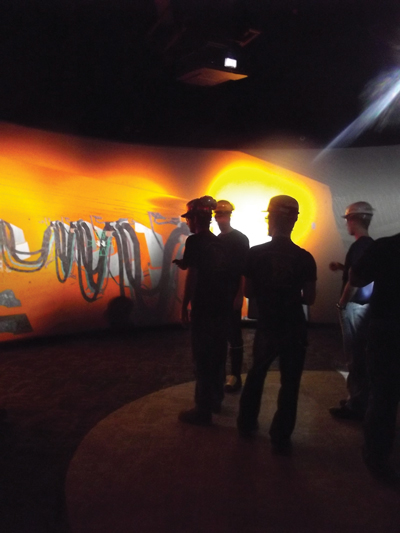 |
| A mine rescue scenario involving multiple victims leads a team into a virtual longwall face. |
NIOSH VIRTUAL RESEARCH EXPERIENCE
“How much experience do you have as a miner and mine rescue team member?” “How often does your team train?” “How many mine rescuers do you interact with on a regular basis outside of work and practice?”
These questions seem simple and innocuous enough, but they are helping to build a vast, detailed database of knowledge for researchers at the National Institute for Occupational Safety and Health (NIOSH) in Pittsburgh, Pennsylvania.
Over the course of nearly a year and culminating November 4 with a large group of mining engineering students from West Virginia University, NIOSH researchers led by Michael Brnich and Launa Mallett have spent hundreds of hours studying 10 mine rescue groups of varying skill levels from universities and mining operations nationwide inside the agency’s 360˚ virtual reality laboratory on the vast campus of the Pittsburgh Research Laboratory.
A portion of each of the 10 one-day events included groups experiencing mine escape training exercises in the virtual environment laboratory, which features a full-height screen and technology from Mechodyne viewable in 3-D with the use of lightweight glasses. In the second segment of the day, each of the teams worked independently on a mine rescue exercise based around a longwall face explosion.
Throughout each group’s time at the laboratory, a series of questionnaires were completed by each individual on simple questions such as virtual reality experience to more complex queries including knowledge-based testing on mine rescue techniques. Team members were also asked to critique one another and the level of efficacy of each member and the team as a unit. During the experience, Brnich and his team studied group dynamics — how the members interacted with one another and with the team’s leader — and their physical and verbal responses to being in an emergency situation. Every glance at the mine map and each piece of dialogue was carefully catalogued for further review.
“The work on the project began back in 2008 when several of our researchers visited Australia and toured VR training facilities in New South Wales and Queensland,” Brnich noted. “Australia has been successfully using virtual environments for mine rescue and emergency response training since the early 2000s and have found immersive environments to be highly valuable for teaching critical emergency response skills by placing trainees in mining environments that would be impossible to replicate in the real world.”
In fact, he noted, the facility at the NIOSH campus was patterned in part after the facility the researchers worked with in Australia, modified by NIOSH for technologies and for broader research needs, with the ultimate goal of examining the efficacy of using virtual environments for mine emergency response training. From options to tap on the mine roofs and even conduct a gas check, every potential movement was presented on the stereoscopic projection screen for the team members and each step using a game system controller was logged and recorded for a subsequent debriefing of the experience.
“There is strong interest in the mining community for using virtual-based training for a variety of applications, including equipment operator training as well as mine rescue and escape training,” Brnich said, noting that much of the self-report data that researchers have been collecting until this point will aid them in understanding trainees’ perceptions of their learning experience in the virtual environment.
Over the coming months as NIOSH studies the responses it has gathered along with its observational notes, it will also be able to assess the effectiveness of virtual environments as training tools, obtained in large part by its pre-and post-experience knowledge-focused lines of questioning.
With the team experience phase of the project just completed this month, Brnich and Mallett note that it will be months before their end result — a detailed report on its findings — will be ready for release.
“At the earliest, we probably won’t be able to report on our findings until at least late in the first quarter of next year,” Brnich said.
“We see reports of our findings as being useful to inform the mining community of the utility of training with virtual environments and, perhaps, spark debate about expanding the use of virtual reality for a variety of mine safety and health training content.”
Coal Age will revisit Brnich and Mallett’s work in 2015 at the conclusion of the project to learn more about lessons learned and how the industry can best utilize virtual reality technology going forward.
Second Annual Mine Rescue Day
The U.S. Department of Labor’s Mine Safety and Health Administration commemorated the second annual Mine Rescue Day on Thursday, October 30, during a meeting of the Holmes Mine Rescue Association (HMRA) at the National Mine Health and Safety Academy in Beaver, West Virginia.
The date for Mine Rescue Day was selected because of its historic significance; on October 30, 1911, the first national mine rescue demonstration was held in the United States, organized by Dr. Joseph A. Holmes, who, in 1910, was appointed as the first director of the U.S. Bureau of Mines by then-President William Howard Taft. Holmes and Taft attended the inaugural event at Forbes Field in Pittsburgh.
On this date last year, the newly created national HMRA, which mine emergency response stakeholders overwhelmingly supported, formally came into existence. The HMRA provides support and guidance for mine rescue to the more than 13,000 mines throughout the country. It also serves as a vehicle to disseminate guidelines, training and tools to the mining community.
In 2010, MSHA began an extensive review of mining community’s mine emergency response strategies to identify shortcomings, and that evaluation process has resulted in several actions and improvements, including technology developments, the addition of a new mine rescue response station in Madisonville, Kentucky, to service the Midwest states, an upgrade to the agency’s mobile response vehicles and command center equipment, mock mine emergency events with mining companies, the revision of criteria for mine rescue team certification (it now includes hands-on skills training), and an overhaul of national mine rescue training contests.
“Mine rescue is among the most risky and challenging rescue work undertaken in this country,” said Joseph Main, assistant secretary of labor for mine safety and health.
“These brave rescuers often travel miles in the dark, navigating underground mine workings filled with debris and poisonous and explosive gases after devastating mine fires, explosions or cave-ins, trying to find missing miners or recovering those who did not survive. We owe these volunteers from the mining community the best training and support available for such high-risk missions.
“And on Mine Rescue Day, we especially owe them the recognition they deserve for putting their own lives on the line to help their fellow miners.”


